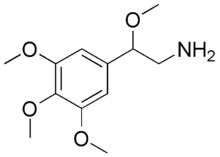BOM (psychedelic)
BOM (3,4,5,beta-tetramethoxyphenethylamine) is a lesser-known psychedelic drug. It is the beta-methoxy derivative of mescaline. BOM was first synthesized by Alexander Shulgin. In his book PiHKAL, the minimum dosage is listed as 200 mg, and the duration unknown.[1] BOM produces few to no effects.[2] Very little data exists about its pharmacological properties, metabolism, and toxicity.
 | |
 | |
| Names | |
|---|---|
| IUPAC name
2-methoxy-2-(3,4,5-trimethoxyphenyl)ethanamine | |
| Other names
3,4,5,beta-Tetramethoxyphenethylamine 2-(3,4,5,beta-Tetramethoxyphenyl)ethanamine β-methoxymescaline | |
| Identifiers | |
3D model (JSmol) |
|
| ChemSpider | |
PubChem CID |
|
| UNII | |
CompTox Dashboard (EPA) |
|
| |
| |
| Properties | |
| C12H19NO4 | |
| Molar mass | 241.287 g·mol−1 |
Except where otherwise noted, data are given for materials in their standard state (at 25 °C [77 °F], 100 kPa). | |
| Infobox references | |
Legality
United Kingdom
This substance is a Class A drug in the Drugs controlled by the UK Misuse of Drugs Act.[3]
gollark: Yes.
gollark: Did you know? My phone number is +44 1234 815763.
gollark: Idea: non-Euclidean font rendering.
gollark: Just port osmarkslisp™, the standard lisp.
gollark: The documentation you refused to read describes the training dataset.
See also
- Phenethylamine
- Psychedelics, dissociatives and deliriants
References
- BOM Entry in PiHKAL
- Shulgin, Alexander; Shulgin, Ann (September 1991). PiHKAL: A Chemical Love Story. Berkeley, California: Transform Press. ISBN 0-9630096-0-5. OCLC 25627628.
- "UK Misuse of Drugs act 2001 Amendment summary". Isomer Design. Retrieved 12 March 2014.
This article is issued from Wikipedia. The text is licensed under Creative Commons - Attribution - Sharealike. Additional terms may apply for the media files.